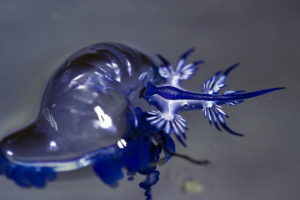A running joke between divers purports that there are two types of divers: those who enjoy nudibranchs and those who don’t. This nudibranch sub-species however, the Glaucus Atlanticus, is no doubt adored by all divers thanks to its beauty and fascinating taxonomy.
Glaucus Atlanticus camouflage
Also called the blue sea slug or the blue dragon, the Glaucus Atlanticus drifts upside down on the ocean’s surface. Its iridescent countershading coloration helps protect it from both airborne and marine predators. Its underside, which faces toward the sky, will appear blue from above. This makes predators think that it’s just another bit of water. When seen from below, the upper side appears gray to mimic the sky. Predators below are thusly uninterested.
Habitat and biology

Unlike other nudibranchs, the Glaucus Atlanticus inhabits the entire water column. Although, as stated, it’s more common on the ocean’s surface. Typically found in temperate and tropical waters of the Atlantic, Pacific and Indian Oceans, the 1.2-inch (3 cm) creature’s diet is comprised of hydrozoans, especially its most common prey, the Portuguese man o’ war, whose tentacles can reach up to 30 feet long (9 m). Eating the highly-venomous stinging cells of the man o’ war creates yet another facet of self-defense since the blue sea slug stores the venom in each of its 84 finger-like cerata. These stick out from its body, allowing it to harm potential predators who may take a nibble or brush by too closely. Consequently, divers and ocean enthusiasts must take caution and never handle this unique creature.
Subspecies
There are two sub-species in the family of Glaucidae, the Glaucus Atlanticus and the Glaucus marginatus. The former is the larger of the two with a much larger tail. But despite its smaller size, only reaching ½ inch (12 mm), the marginatus has more cerata than its counterpart, creating a smaller yet more venomous threat. Just as with other nudibranchs, they are hermaphroditic, each creating its own sperm and eggs. Each individual must however find a mate to fertilize the eggs.
Seeing one of these beautiful creatures on a dive is always a treat. But remember that they’re highly venomous, so — just as with other sea creatures — look but don’t touch.

